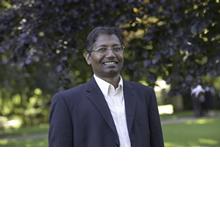Statisticians predict with greater accuracy using new modelling methods
The role of statisticians in improving our understanding and monitoring of global issues such as pollution levels, cancer mortality rates, crime statistics and the spread of diseases, will be discussed at an international workshop being held at the University of Southampton today and tomorrow.
Experts from 11 countries are attending the two-day workshop at the University's Statistical Sciences Research Institute which focuses on new statistical methods, in particular in relation to 'spatio-temporal modelling' - modelling of data which varies across both space and time.
Dr Sujit Sahu of the University's School of Mathematics explains: "Spatio-temporal modelling is enabling advances in a wide range of application areas, including the study of house prices, ecology, geology and many areas of medicine such as brain imaging.
"A simple example of this form of modelling is a weather forecast map on television. The map shows how aspects of the weather vary in both space and time. For the forecast to be effective, it is important to predict, or forecast, many variables that describe the weather - such as the amount of rainfall, sunshine and air pollution. Typically, such predictions are made from data observed on a large number of variables, which themselves vary over time and space," he added.
"Spatio-temporal data sets can also be very large. Air pollution measurements, for example, are observed daily at over one hundred locations in the UK and data may go back over the last ten years."
In order to obtain a high degree of accuracy in analysis and predictions, mathematical models are used, which explicitly include the underlying uncertainty in the data. These models are statistical in nature and, if appropriately chosen, allow accurate forecasting in future time periods. In addition, they allow the statisticians to estimate the size of possible errors associated with the forecasts.
Related Staff Member
Notes for editors
- The Workshop on Recent Advances in Modelling Spatio-temporal Data takes place at the University of Southampton on Wednesday 25 and Thursday 26 May.
- Talks at the meeting cover a wide variety of applications, including:
* The UK 2001 foot and mouth epidemic, and bovine tuberculosis in Cornwall
* Ocean temperature and salinity
* Air pollution levels
* Brain activities in fMRI images
* Variation in cancer mortality in Greece and in West Germany
* Radiocarbon dating and methods in palaeoclimate reconstruction
* Crime statistics in Brazil and Japan
* Health system planning for malaria in Kenya - The Southampton Statistical Sciences Research Institute, known as S3RI, was set up by the University in August 2003 to support and co-ordinate the research activities of statisticians and demographers from the Schools of Social Science, Mathematics and Medicine - it involves more than 50 academic, research and support staff.
- The main organisers of this meeting are from the School of Mathematics: Dr Sujit Sahu and Professor Susan Lewis (Deputy Director of S3RI)
- The University of Southampton is a leading UK teaching and research institution with a global reputation for leading-edge research and scholarship. The University has around 20,000 students and nearly 5000 staff. Its annual turnover is in the region of £270 million.
